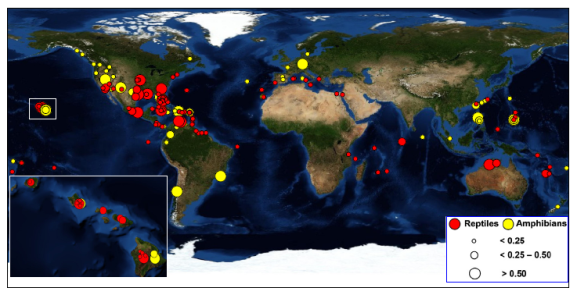外来物种扩展速率存在地理差异
来源:《生态学通讯》
作者:李义明等
时间:2014-06-06

日前,中科院动物所多样性与空间生态学研究组探讨了107种外来两栖爬行物种在全球201个入侵区的扩展速率,并量化了物种特性、入侵区特征和人为活动对扩展速率的贡献。这是在全球尺度上对外来物种扩展速率及其影响因素的首次报道,相关论文在线发表于《生态学通讯》。
随着经济的全球化,外来物种入侵的数量呈指数形式增长,对当地经济和生物多样性构成严重威胁。然而,之前对外来种扩展速率的研究大多集中在单一物种,或聚焦在区域尺度上,研究结果易受物种特性、地理异质性、种群统计随机性或遗传随机性的影响,难以得出可靠的结论。
该研究发现,入侵区的扩展速率存在地理上的差异,但类群间差异不明显。同一物种在不同入侵区的扩展速率可相差10倍之多。控制类群非独立性和地理非独立性后,扩展速率与当地同类物种的多样性及人为协助扩散呈正相关,而与入侵区的地形异质性呈负相关。外来种的特性,如原产地分布区面积、是否水生物种,是否在流水中繁殖、个体大小、窝卵数、性成熟年龄和脑容量以及其他因素如入侵区的岛屿化程度,入侵区与原产地的气候相似性程度,人为引种方式和入侵区的人口密度均对扩展速率影响很小。
研究者建议当地同类物种多样性高及地形异质性低的区域应该是外来两栖爬行动物管控的重点;同时,应尽量减少人为协助再扩散的发生,加强助长引种的社会学和心理学原因的探讨。该研究强调,在发展物种分布区变化的预测框架时,应重视栖息地特征和人为活动因素的作用。(来源:中国科学报 陆琦)
Congener diversity, topographic heterogeneity and humanassisted dispersal predict spread rates of alien herpetofauna at a global scale
Abstract Understanding the factors that determine rates of range expansion is not only crucial for developing risk assessment schemes and management strategies for invasive species, but also provides important insight into the ability of species to disperse in response to climate change. However, there is little knowledge on why some invasions spread faster than others at large spatiotemporal scales. Here, we examine the effects of human activities, species traits and characteristics of the invaded range on spread rates using a global sample of alien reptile and amphibian introductions. We show that spread rates vary remarkably among invaded locations within a species, and differ across biogeographical realms. Spread rates are positively related to the richness of native congeneric species and human-assisted dispersal in the invaded range but are negatively correlated with topographic heterogeneity. Our findings highlight the importance of environmental characteristics and human-assisted dispersal in developing robust frameworks for predicting species’ range shifts.
原文链接:http://onlinelibrary.wiley.com/doi/10.1111/ele.12286/pdf




